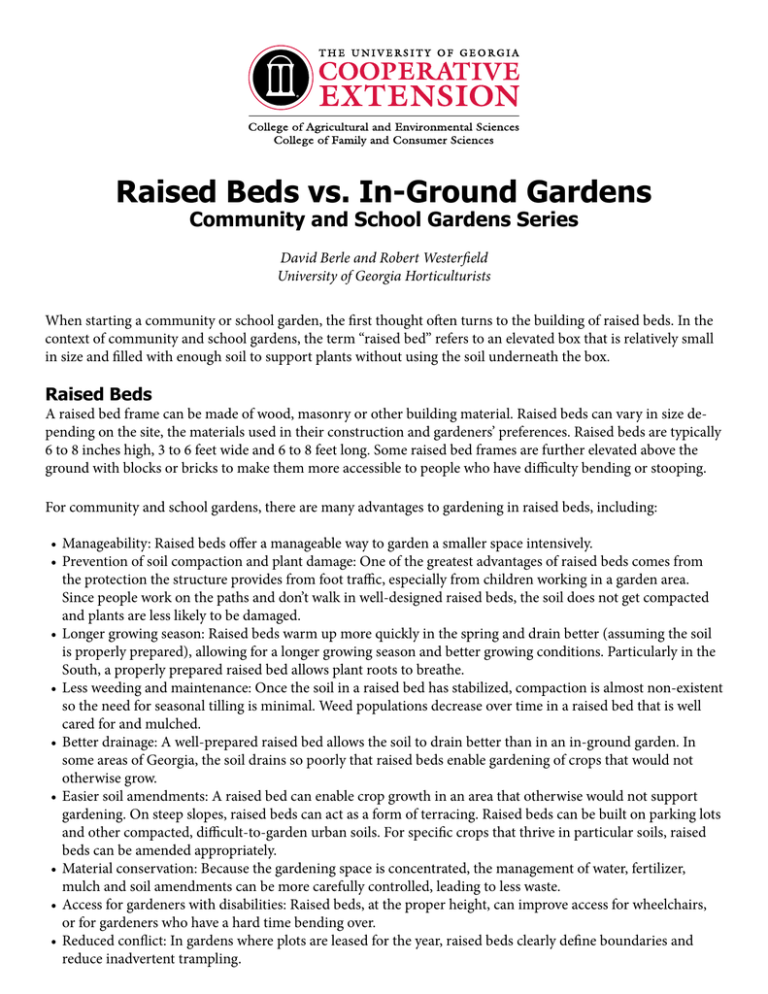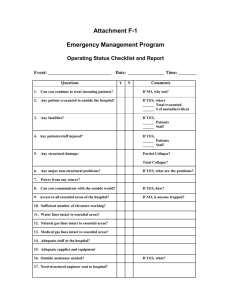Raised Beds vs. In-Ground Gardens Community and School Gardens Series
advertisement

Raised Beds vs. In-Ground Gardens Community and School Gardens Series David Berle and Robert Westerfield University of Georgia Horticulturists When starting a community or school garden, the first thought often turns to the building of raised beds. In the context of community and school gardens, the term “raised bed” refers to an elevated box that is relatively small in size and filled with enough soil to support plants without using the soil underneath the box. Raised Beds A raised bed frame can be made of wood, masonry or other building material. Raised beds can vary in size depending on the site, the materials used in their construction and gardeners’ preferences. Raised beds are typically 6 to 8 inches high, 3 to 6 feet wide and 6 to 8 feet long. Some raised bed frames are further elevated above the ground with blocks or bricks to make them more accessible to people who have difficulty bending or stooping. For community and school gardens, there are many advantages to gardening in raised beds, including: • Manageability: Raised beds offer a manageable way to garden a smaller space intensively. • Prevention of soil compaction and plant damage: One of the greatest advantages of raised beds comes from the protection the structure provides from foot traffic, especially from children working in a garden area. Since people work on the paths and don’t walk in well-designed raised beds, the soil does not get compacted and plants are less likely to be damaged. • Longer growing season: Raised beds warm up more quickly in the spring and drain better (assuming the soil is properly prepared), allowing for a longer growing season and better growing conditions. Particularly in the South, a properly prepared raised bed allows plant roots to breathe. • Less weeding and maintenance: Once the soil in a raised bed has stabilized, compaction is almost non-existent so the need for seasonal tilling is minimal. Weed populations decrease over time in a raised bed that is well cared for and mulched. • Better drainage: A well-prepared raised bed allows the soil to drain better than in an in-ground garden. In some areas of Georgia, the soil drains so poorly that raised beds enable gardening of crops that would not otherwise grow. • Easier soil amendments: A raised bed can enable crop growth in an area that otherwise would not support gardening. On steep slopes, raised beds can act as a form of terracing. Raised beds can be built on parking lots and other compacted, difficult-to-garden urban soils. For specific crops that thrive in particular soils, raised beds can be amended appropriately. • Material conservation: Because the gardening space is concentrated, the management of water, fertilizer, mulch and soil amendments can be more carefully controlled, leading to less waste. • Access for gardeners with disabilities: Raised beds, at the proper height, can improve access for wheelchairs, or for gardeners who have a hard time bending over. • Reduced conflict: In gardens where plots are leased for the year, raised beds clearly define boundaries and reduce inadvertent trampling. In-Ground Gardens For many school and community gardens, growing directly in the ground offers significant advantages. Gardening in the ground allows the use of tractors to initially prepare areas and the start-up costs are far lower than for raised beds. Other advantages include: • Use of existing soil: Most soils are perfectly fine for gardening, provided the soil is properly tilled, mulched and watered. Even without organic amendments, most Georgia soils can produce a bountiful harvest. • Financially economical: By using existing soil and not importing soil, money can be saved and used for organic amendments that would be needed to improve even the imported soil. Since it is highly unlikely to find real topsoil in Georgia, it is often better to improve what you have than import something new and possibly unknown. Purchased topsoil is usually either man-made (consisting largely of bark and sand) or similar to the soil already available on-site. If amended properly, clay soils have benefits that are not found in man-made soils. If you are uncertain of the quality of your soil or how to amend it, take samples to your local county Extension agent for testing. See http://aesl.ces.uga.edu/soiltest123/Georgia.htm for information on how to do this. If there is any chance the soil has been contaminated with potentially toxic compounds, ask to have the soil tested for heavy metals. • Less start-up work: A flat, well-drained area can be prepared with a tractor or large roto-tiller. • Less permanent: An in-ground garden can easily be replaced with another crop or moved to another location. • Lower water requirements: In-ground beds won’t dry out as quickly as raised beds and will therefore require less water to maintain. • Easier irrigation: Irrigation systems for flat, in-ground gardens are simple to design and easy to install compared to raised beds that require careful design and installation. While there are many advantages to raised beds, there are also some disadvantages. Raised beds require the construction of a wall or edge restraint. While this can be built with recycled materials, it still requires additional work, at least initially. Elevated raised beds are even more expensive and require some degree of engineering to support the weight of the soil. Raised beds also need to be filled with soil, which can become expensive and requires a good understanding of soils and soil amending. Raised beds are more permanent than in-ground gardens, so planning for future use is essential. Some crops are not well suited to raised bed production. For example, sweet corn requires larger blocks of plants to ensure proper pollination. Watermelons tend to overtake a small raised bed, unless compact varieties are grown and perhaps trellised. Finally, most raised bed gardens rely exclusively on hand labor for all tasks, including planting, fertilizing and weeding. Before starting a community or school garden, it is important to consider which type of garden is appropriate for your current and future needs and the amount of time and resources your situation will require. See the other publications in this series for more information about planning, creating and sustaining a community or school garden. February 2013 Circular 1027-3 The University of Georgia and Ft. Valley State University, the U.S. Department of Agriculture and counties of the state cooperating. Cooperative Extension, the University of Georgia College of Agricultural and Environmental Sciences, offers educational programs, assistance and materials to all people without regard to race, color, national origin, age, gender or disability. The University of Georgia is committed to principles of equal opportunity and affirmative action.





